
Tohoku consists of the 6 prefectures in the northeast of the main island of Honshu.
Aomori Prefecture
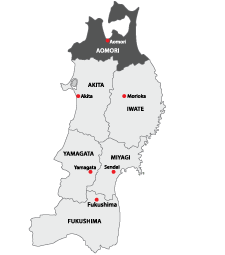 Aomori is the northernmost prefecture on the main island of Honshu, surrounded on three sides by the ocean. Consequently, seafood is a highlight of the local cuisine. Within Aomori, three distinct cultures arose – the Tsugaru, Nanbu, and Mutsu – divided in part by geography and in part by the power struggle of lords in the pre-Edo period. In the West, the Aomori and the Tsugaru areas are known for their August Nebuta festivals where enormous colorful and fearsome lanterns move through the city. The Hakkoda mountain range offers alpine flowers in summer and skiing in winter. Year-round, geothermal activity fuels the hot springs of Sukayu Onsen and its ‘1000 person bath’.
Aomori is the northernmost prefecture on the main island of Honshu, surrounded on three sides by the ocean. Consequently, seafood is a highlight of the local cuisine. Within Aomori, three distinct cultures arose – the Tsugaru, Nanbu, and Mutsu – divided in part by geography and in part by the power struggle of lords in the pre-Edo period. In the West, the Aomori and the Tsugaru areas are known for their August Nebuta festivals where enormous colorful and fearsome lanterns move through the city. The Hakkoda mountain range offers alpine flowers in summer and skiing in winter. Year-round, geothermal activity fuels the hot springs of Sukayu Onsen and its ‘1000 person bath’.
Hirosaki is famous for its sakura or cherry blossoms in spring in the area around Hirosaki Castle. UNESCO World Heritage site Shirakami Sanchi was Japan’s first natural UNESCO site. The primeval beech forests here are revered as the home of the kami or spirits. The Juniko (Twelve Lakes) area of the Shirakami Sanchi is home to Aoike pond – a pond so clear that the water takes on a cobalt blue appearance. Natural beauty can also be found East of the Ou mountains. The Oirase Keiryu flowing between Yakeyama and Lake Towada offers beautiful scenic streamside walking. Lake Towada, Japan’s only dual crater lake, offers a variety of shoreline views that merit discovery from the water itself. Hachinohe lies near the Tanesashi coast which has inspired scores of authors with its beauty. Commercially, the mackerel and squid caught from the Pacific have been key to the development of the city. A visit to the morning markets of the area is a highlight for culinary travelers. Over 50% of Japan’s apples grow in the region. Tsugaru lacquerware, Hiba woodcrafts, Kokeshi dolls, and Tsugaru Kanayamayaki pottery are Aomori crafts with a long history.



Akita Prefecture
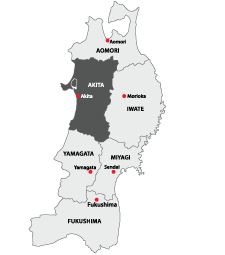 South of Aomori, the Ou mountain range roughly divides Akita and Iwate prefectures. Akita may be known for the breed of dog that originates from this area, but the area also is naturally beautiful. The Shirikami Sanchi extends into Akita. Lake Tazawa is the deepest of Japan’s lakes, with water so clear that it is possible to see fish swimming within from the surface. The Oga Peninsula extends into the Sea of Japan, and during its New Year festival, Namihage, scary demons that warn against laziness and ill deeds visit local households to bestow blessings for the year ahead. An extensive calendar of festivals keeps the year lively in Akita prefecture. Kakunodate retains its Edo period traditional architecture of samurai residences. It is a firm favourite for cherry blossom viewing in the north. For those seeking the relaxation of an onsen, Nyuto Onsen and Tamagawa onsen are firm favourites, and Goshogake onsen offers mud baths. In the winter months, the Yokote area is lit up with small snow houses during the Kamakura festival. Warming up with a soup containing kiritampo, a local rice dumpling, will help keep the cold at bay. In summer, Akita City’s Kanto matsuri lights up the night with bamboo poles festooned with lanterns – carefully balanced by their carriers. The prefecture is known not just for its cherry blossoms in spring but also for the crafts created by revealing the rich color underlying cherry tree bark.
South of Aomori, the Ou mountain range roughly divides Akita and Iwate prefectures. Akita may be known for the breed of dog that originates from this area, but the area also is naturally beautiful. The Shirikami Sanchi extends into Akita. Lake Tazawa is the deepest of Japan’s lakes, with water so clear that it is possible to see fish swimming within from the surface. The Oga Peninsula extends into the Sea of Japan, and during its New Year festival, Namihage, scary demons that warn against laziness and ill deeds visit local households to bestow blessings for the year ahead. An extensive calendar of festivals keeps the year lively in Akita prefecture. Kakunodate retains its Edo period traditional architecture of samurai residences. It is a firm favourite for cherry blossom viewing in the north. For those seeking the relaxation of an onsen, Nyuto Onsen and Tamagawa onsen are firm favourites, and Goshogake onsen offers mud baths. In the winter months, the Yokote area is lit up with small snow houses during the Kamakura festival. Warming up with a soup containing kiritampo, a local rice dumpling, will help keep the cold at bay. In summer, Akita City’s Kanto matsuri lights up the night with bamboo poles festooned with lanterns – carefully balanced by their carriers. The prefecture is known not just for its cherry blossoms in spring but also for the crafts created by revealing the rich color underlying cherry tree bark.



Iwate Prefecture
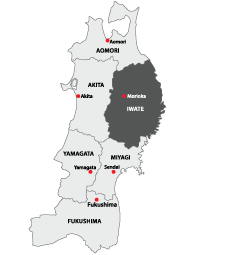 Iwate lies to the east of Akita on the Pacific and its northern and southern regions were once ruled by two different powerful samurai families. In the Iwate portion of the Sanriku Geopark, Jodogahama Beach is recognized as one of the most beautiful stretches of the Japanese coastline. Equally dramatic, the 50m limestone cliffs that form the sides of Gekibei Gorge act as a frame to the often emerald-colored waters. Moving above ground to below ground, the stunning landscapes also include Ryusendo limestone caves’ stalactites and bats against a backdrop of a shimmering blue underground lake. Appi Kogen offers skiing in winter, and in summer, grassy highlands are punctuated by groves of white birches. Koiwai farm, known for its dairy products throughout Japan, is found in Iwate and it is possible to visit the farm. Iwate is not known just for its natural beauty. Chuson-ji Temple in Hiraizumi is a UNESCO World Heritage site associated with Pure Land Buddhism and the Oshu Fujiwara family. It is famous for its Konjikido, a gold leaf-covered hall that is over 800 years old. Nearby Motsu-ji temple is known for its Pure Land garden surrounding the Oizumi-ga-ike pond. Traditional folk dances have been passed down by generations over 1000 years. Tono is known for its legends of mythical Kappa creatures. Sustainably harvested abalone is also a specialty of the region. Morioka’s culinary claim to fame is wanko soba an all-you-can-eat experience unlike any other. Small bowls of soba are delivered to dinners in fast succession. For those that prefer a slower dining experience, Morioka also offers Reimen and Jajamen – two other local noodle variations. Maezawa beef is one of the wagyu regional designations known for its marbling and melt-in-the-mouth texture. Iwate’s ironworkers are known for their skill in forging Nambu teapots that are still highly prized in Japan today. The simplicity of the Jojobi lacquerware highlights the skill of its creation. The Hachimantai region that stretches between Akita and Iwate includes Toshichi Onsen. Hanamaki Osenkyo is another popular hot springs area.
Iwate lies to the east of Akita on the Pacific and its northern and southern regions were once ruled by two different powerful samurai families. In the Iwate portion of the Sanriku Geopark, Jodogahama Beach is recognized as one of the most beautiful stretches of the Japanese coastline. Equally dramatic, the 50m limestone cliffs that form the sides of Gekibei Gorge act as a frame to the often emerald-colored waters. Moving above ground to below ground, the stunning landscapes also include Ryusendo limestone caves’ stalactites and bats against a backdrop of a shimmering blue underground lake. Appi Kogen offers skiing in winter, and in summer, grassy highlands are punctuated by groves of white birches. Koiwai farm, known for its dairy products throughout Japan, is found in Iwate and it is possible to visit the farm. Iwate is not known just for its natural beauty. Chuson-ji Temple in Hiraizumi is a UNESCO World Heritage site associated with Pure Land Buddhism and the Oshu Fujiwara family. It is famous for its Konjikido, a gold leaf-covered hall that is over 800 years old. Nearby Motsu-ji temple is known for its Pure Land garden surrounding the Oizumi-ga-ike pond. Traditional folk dances have been passed down by generations over 1000 years. Tono is known for its legends of mythical Kappa creatures. Sustainably harvested abalone is also a specialty of the region. Morioka’s culinary claim to fame is wanko soba an all-you-can-eat experience unlike any other. Small bowls of soba are delivered to dinners in fast succession. For those that prefer a slower dining experience, Morioka also offers Reimen and Jajamen – two other local noodle variations. Maezawa beef is one of the wagyu regional designations known for its marbling and melt-in-the-mouth texture. Iwate’s ironworkers are known for their skill in forging Nambu teapots that are still highly prized in Japan today. The simplicity of the Jojobi lacquerware highlights the skill of its creation. The Hachimantai region that stretches between Akita and Iwate includes Toshichi Onsen. Hanamaki Osenkyo is another popular hot springs area.



Yamagata Prefecture
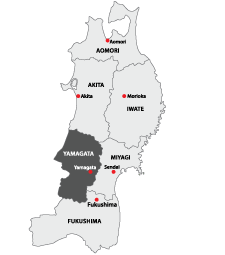 Yamagata prefecture is located south of Akita on the Sea of Japan side of Tohoku. The three peaks of the Dewa Sanzan area are strongly associated with the shugendo faith, which combines elements of nature worship, Shintoism, and esoteric Buddhism. Yamabushi, or mountain ascetic priests, worship in the natural settings of Yamagata. The three mountains of Dewa Sanzan, Haguro, Gassan, and Yudono are sites of pilgrimage and reverence and are said to be representative of birth, death, and rebirth. The towns at the foot of the mountains contain pilgrims’ lodgings welcoming those making the trek. Some monks have taken ascetism to its extreme and are self-mummified at Dainichibo and Churenji.
Yamagata prefecture is located south of Akita on the Sea of Japan side of Tohoku. The three peaks of the Dewa Sanzan area are strongly associated with the shugendo faith, which combines elements of nature worship, Shintoism, and esoteric Buddhism. Yamabushi, or mountain ascetic priests, worship in the natural settings of Yamagata. The three mountains of Dewa Sanzan, Haguro, Gassan, and Yudono are sites of pilgrimage and reverence and are said to be representative of birth, death, and rebirth. The towns at the foot of the mountains contain pilgrims’ lodgings welcoming those making the trek. Some monks have taken ascetism to its extreme and are self-mummified at Dainichibo and Churenji.
The Zao mountains straddle Yamagata and Miyagi prefectures and offer adventure in winter sports with skiing and snowboarding. Even those who do not engage in winter sports may be entranced by the otherworldly looking ‘snow monsters’ found at Zao – treetops so glazed with snow to have taken on an almost haunting mysterious appearance. In warmer months, the area offers hiking and camping. Zao Onsen and Ginzan Onsen are picturesque hot springs in the area. Ginzan Onsen takes its name from the nearby silver mine and is also known for its Kaminohata-yaki pottery. Kaminoyama Onsen lies below Zao Onsen and its small samurai district and castle lend its charms to the town. Several fruit farms are nearby, fed by the river that runs through Yamagata prefecture feeding the lowland orchards. Risshaku-ji, otherwise known as Yamadera, is a Tendai Buddhist temple perched on a cliff high above Yamagata city. The temple, founded in the year 860, is accessed by climbing over 1000 steps through cedar woods and is immortalized in one of Poet Matsuo Basho’s haiku.
Some of the smaller towns of Yamagata retain a traditional feel of the Edo period. The town of Tendo is known for its manufacture of shogi sets and this chess-like game of strategy remains popular throughout Japan. Sakata still bears the traces of the powerful Honma family that ruled the area in its museum of art, preserved warehouse district, and the Honma residence.



Miyagi Prefecture
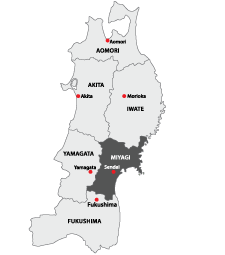 Miyagi lies to the east of Yamagata prefecture and is itself bordered by the Pacific Ocean. In the Zao mountains in the West of the prefecture, the Okama Crater lake changes color in varying light. The Miyagi side of Zao is also home to the ‘fox village’ in Shiroishi. 100 foxes of six different varieties roam freely in the area.
Miyagi lies to the east of Yamagata prefecture and is itself bordered by the Pacific Ocean. In the Zao mountains in the West of the prefecture, the Okama Crater lake changes color in varying light. The Miyagi side of Zao is also home to the ‘fox village’ in Shiroishi. 100 foxes of six different varieties roam freely in the area.
Matsushima Bay still retains its place as one of the three most scenic views of Japan, with 260 small islands dotting the water. Viewed from the Shitaikan, one of the four main vantage points over the bay, it is easy to see why Matsushima keeps its ranking amongst the most scenic views! Ishinomaki and Kesennuma were two seaside towns hard hit by the 2011 tsunami. Reconstruction continues in these communities and residents appreciate the support of tourists visiting the area. The seacoast of Miyagi prefecture is a spectacular location for sea-kayaking in the pleasant summer months. Freshly harvested oysters and other seafood are a highlight of the coastline. Nearby Shiogama port is heaven for sushi lovers as it is said to have the greatest number of sushi restaurants in Japan. Mackerel, sardines, big-eye tuna, and sea squirts are other delicacies that are a gift of the ocean. In the pastureland of the prefecture, beef graze, and beef tongue is a local specialty, particularly in the Sendai area. Miyagi is known for its rice and sake production.
Sendai is the capital of the prefecture and its main transport hub, both for bullet trains and flights arriving from points north and west. The city is associated with the powerful samurai Date Masamune and his mausoleum, Zuihoden, as well as Sendai Castle are highlights of Sendai. Zuiganji temple was the Masamune family temple and is finely decorated. Sendai is watched over by the impressive Daikannon statue.
In autumn, the foliage at Naruko-kyo gorge transforms the landscape into the colors of sunset – in scarlet, fiery orange, and golden hues. Mt. Kurikoma also is blanketed with autumn color from late October to mid-November. The five hot springs of Naruko Onsen provide for a variety of types of onsen with differing mineral characteristics. In Southern Miyagi, onsen are also found at Akiu, Sakunami, Jogi, Togata. In addition to onsen, Akiu is known for Rairai Gorge and the Akiu Otaki waterfall. Wood-turned Kokeshi dolls are a local craft specialty throughout Miyagi. Sendaihira silk produced in the area makes another great souvenir of Miyagi.



Fukushima Prefecture
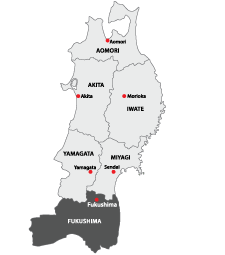 Fukushima is, geographically, one of Japan’s largest prefectures and its history features samurai, preserved villages, and historic temples. Following the 2011 post-tsunami meltdown of the Daiichi power plant visitor numbers dropped, but the restricted access areas in the prefecture form less than 3% of its total area. Western Fukushima has not been impacted.
Fukushima is, geographically, one of Japan’s largest prefectures and its history features samurai, preserved villages, and historic temples. Following the 2011 post-tsunami meltdown of the Daiichi power plant visitor numbers dropped, but the restricted access areas in the prefecture form less than 3% of its total area. Western Fukushima has not been impacted.
The Aizuwakamatsu area was one of the last holdouts of the samurai tradition. The powerful lords of the area had their base at Tsuruga Castle. The Aizu Bukeyashiki offers insights into the lives of samurai in preserved residences and provides background on the impact of the Boshin War on the area. Edo period townscapes remain in Ouchijuku, along its rows of thatched-roof buildings. You may wish to try the local specialty, negi soba, where instead of chopsticks, diners are provided leeks as utensils. Meiji and Taisho-era townscapes still feature in Kitakata, particularly Kura-style storehouses whose thick walls protected local sakes and lacquerware from fire. Entsu Sansodo, known as Sazae-do, is unique in the world as a wooden building constructed as a double helix. On the outskirts of Aizuwakamatsu is Higashiyama Onsen, one of the primary onsen of Tohoku. Nearer to Fukushima city, Iizaka Onsen has a long history, attracting poets and writers over its millennium as an onsen town. Onsen feature throughout Fukushima – another soothing result of the area’s volcanic activity.
The Urabandai area in the North of Fukushima bears the marks of its volcanic origins in its series of lakes and ponds The natural beauty here has produced a varied landscape. Goshikinuma is an area of lakes, ponds, and marshes connected by nature walks. Moving between them you’ll observe the incredible variety of colours of the water. The largest lake in the area, Lake Hibara, offers pleasure boating and lakefront vantage points in the shadow of Mount Bandai. During the winter months, Mount Bandai offers skiing and other winter sports. Due to the terrain, some of the walking is on wooden boardwalks.
Traditional handicrafts in the area include the Akabeko red cows with their bobbing heads, wooden toy horses called Miharu Koma. Washi paper and Aizu lacquerware, as well as the precursors to weebles – okiagari ko boshi dolls – which right themselves when tipped over. Traditionally the area is a fruit-producing region, and as one of Japan’s significant rice-producing regions, it is also known for its sake.



